Top image: US Personnel caring for ill patients in a typhus ward, Dachau, 1945. US Army Signal Corps Photo, Gift of the United States Holocaust Memorial Museum, from the Collection of The National World War II Museum, 2009.373.057
The historic winter of 1944-45 tested the endurance of the Dachau concentration camp’s captive population. News, much of it good, about the Allies’ recent triumphs —stopping Adolf Hitler’s Ardennes Offensive and the unleashing of the Red Army’s Vistula-Oder Offensive (mid-January 1945)—seeped in. As the weeks passed, confidence in Allied victory, while fragile, struck roots in Dachau.
There were powerful reasons for inmates, though, to temper expectations. Despite the fragmentary knowledge of the state of the war they gained, there was much uncertainty about how long the Hitler regime might withstand the Allied advance. Due to its location in Bavaria, quite distant from the battle fronts, liberation would not happen anytime soon. Undoubtedly, the omnipresence of the SS guaranteed that attempted escape or rebellion would be met with extreme violence.
Other factors besides the SS’s wanton cruelty incited new terror among Dachau’s prisoners. Food supplies dwindled just as thousands of arrivals evacuated from other camps had to be fed. In short order, overcrowding, disease (particularly typhus), and malnutrition followed the bitter cold of winter. Deaths in the camp soared.
Some perspective is needed to comprehend the skyrocketing mortality rate in Dachau. Harold Marcuse’s Legacies of Dachau offers us that. Looking back to the beginning of World War II, he contends that between 1,000 and 3,000 prisoners perished in the camp, annually, between 1940 and 1943. Twice in those three years, the death toll surpassed 400 per month. In the autumn of 1944 a dreadful transition occurred. The numbers who died topped 400 in October, then doubled in November, before reaching 1,915 in December.
Dachau’s final four months of operation in 1945 proved truly catastrophic. Between 2,600 and 4,000 inmates per month succumbed to disease or starvation, roughly 100 every day. With the camp suffering from a shortage of coal since late 1944, the crematoria could not keep pace with the tempo of dying. In response, the SS authorities at Dachau forced prisoners to bring the dead to a hill located close to the camp and bury them in a pit.
As spring began, word reached Dachau that US troops had seized a bridge over the Rhine River at Remagen in early March. Americans now pushed deep into Germany. Munich, the capital of Bavaria and birthplace of National Socialism, was a major target. How long before the Americans reached Dachau?
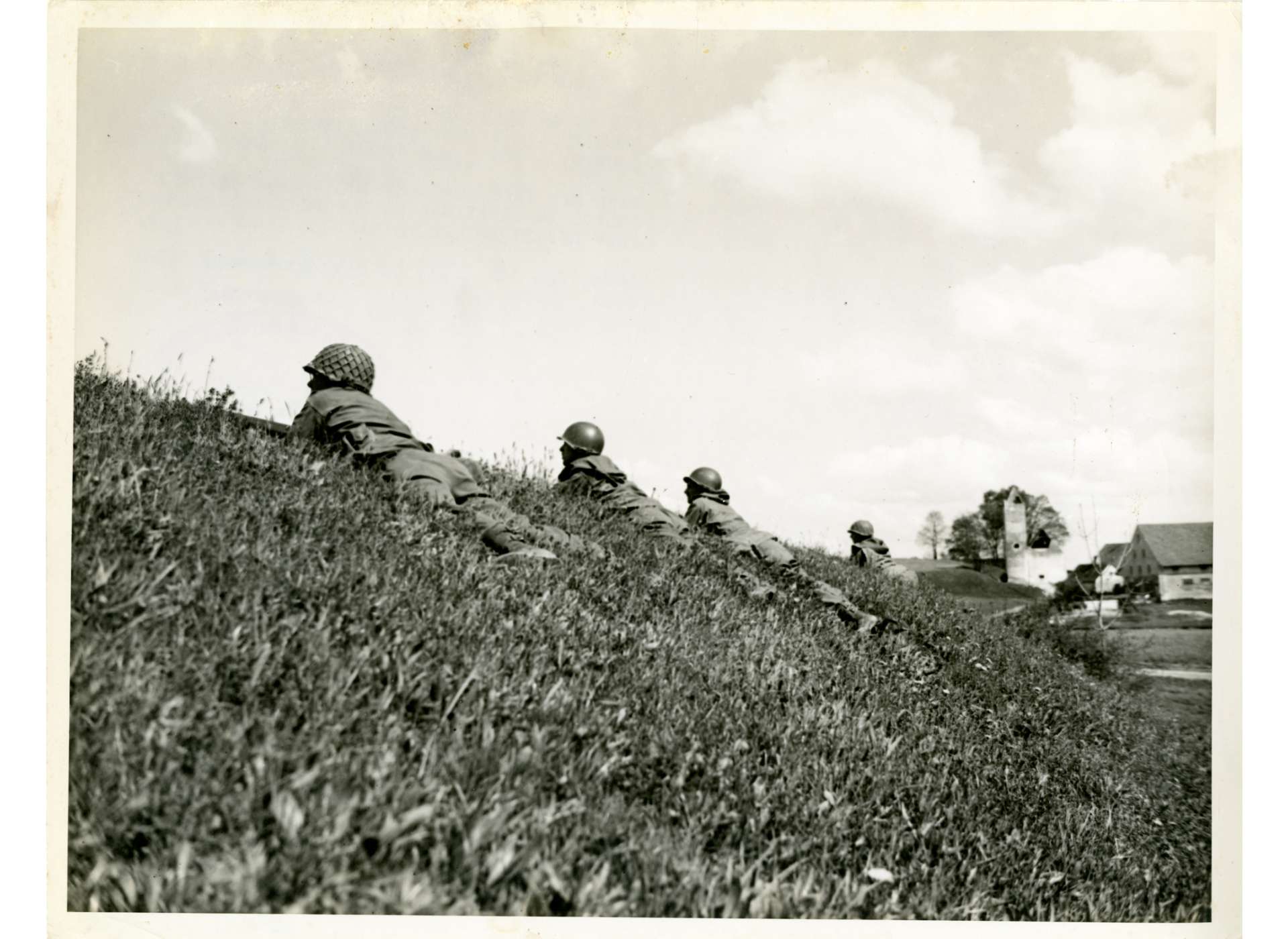
Soldiers from the US 42nd Infantry Division take cover on a ridge in a field near Dachau, April 29, 1945. They were under fire from a group of 30 SS troops. US Army Signal Corps Photo, Gift in Memory of Allan Voluck, from the Collection of The National World War II Museum, 2015.111.084.
Unsurprisingly, rumors, terrible rumors, swirled around the camp. The prospect of evacuation to an uncertain locale loomed, a terrifying prospect given the deteriorating physical condition of the inmates. One of the most frightful disseminated involved the SS liquidating all the prisoners rather than see them liberated. An atmosphere of constant apprehension reigned.
The sense of fear escalated horribly in early April. On April 9, the Nazis put to death Georg Elser, the cabinetmaker whose bomb placed in Munich’s Bürgerbräukeller just missed killing Hitler on November 8, 1939 (the dictator abruptly departed the commemoration of the Beer Hall Putsch minutes before the device detonated). Elser, who had only recently been transferred to Dachau after spending much of the war in the Sachsenhausen concentration camp, was executed with a shot in the back of the neck on the orders of Heinrich Himmler. Himmler commanded that responsibility for Elser’s death be attributed to a raid by the Royal Air Force.
In a few cases, the SS decided to quickly relocate high-profile prisoners, such as Léon Blum, the socialist politician and one-time prime minister of France, the right-wing politician and former Chancellor of Austria, Kurt von Schuschnigg, and the pastor and theologian Martin Niemöller.
Chaos, however, ruled inside Dachau by mid-April 1945. Transports came bearing thousands of emaciated inmates from Buchenwald, Flossenbürg, and the sub-camps of Natzweiler-Struthof, all threatened by the rapid advance of Allied armies. This influx simply overwhelmed Dachau’s capacities. Commandant Eduard Weiter underwent a nervous breakdown. Consequently, Berlin called in Martin Weiss, the former commandant from 1942-43 with a reputation for benevolence among the inmates, to restore some semblance of order and discipline. Weiss initiated communication with Victor Maurer, a representative of the International Red Cross. Maurer was permitted to bring parcels for the inmates but barred from actually inspecting the camp.
Restoring order and discipline proved an impossible task for Weiss. Hitler’s thousand-year Reich was collapsing. The Americans liberated Ohrdruf, a subcamp of Buchenwald, on April 4, the main camp at Buchenwald, as well as Dora-Mittelbau, on April 11, and Flossenbürg on April 23. A torrent of photographs and newsreels flooded the Western mass media from these sites of mass death. On April 15, Field-Marshal Walter Model’s Army Group B surrendered more than 300,000 men to the US in the Ruhr. Five days later, Nuremberg, the Franconian city infamous for the gigantic Nazi Party rallies once orchestrated there, fell to General Alexander Patch’s US Seventh Army.
Soviet troops commenced the assault on Berlin on April 16, completing the encirclement of the German capital within a week. With Hitler confined to the underground bunker in the city and holding onto hopes for a miracle, Himmler desperately and futilely tried to save his own skin. As the totalitarian system the Nazis had erected tottered, panic set in with Dachau’s leaders. They got rid of incriminating evidence. Inmates aided this work by burning documents with lists of names.
With troops of General Patch’s Seventh Army approaching, the SS were also afraid to let inmates remove the steadily accumulating corpses to the mass burial place on the hill. Instead, they just piled up everywhere. For the last several days of its existence, Dachau was a small, self-enclosed universe of decay and death.
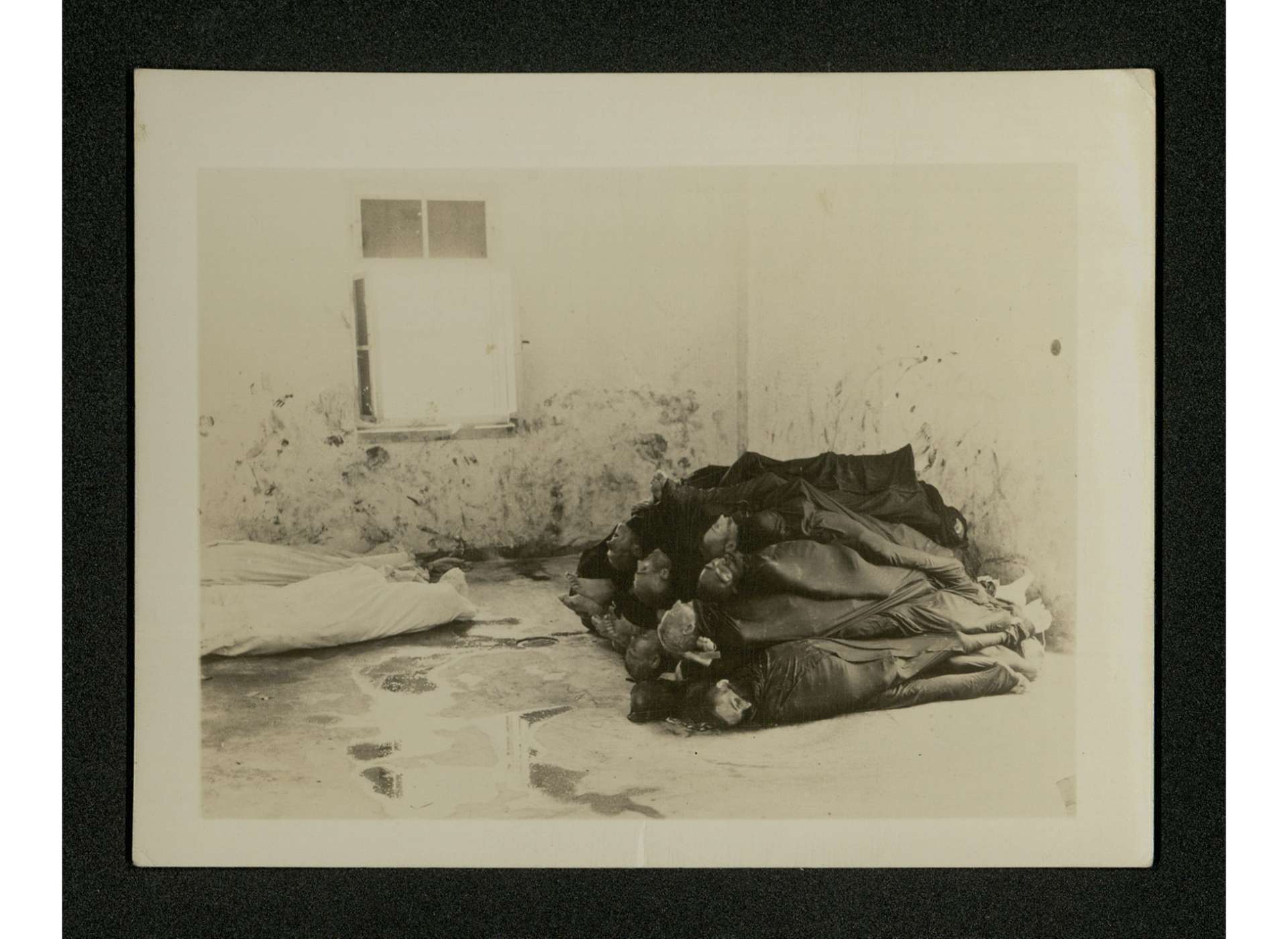
Corpses wrapped and piled in a cement room where blood smears are to be seen on the walls. US Army Signal Corps photo, Gift of the Acosta Family, from the Collection of The National World War II Museum, 2014.057.028.
Oskar Müller, a member of the Communist Party of Germany, was now senior camp inmate in Dachau. Hermann Langbein, who did so much to chronicle life in the camps, related the praise for Müller from other inmates. Even with freedom apparently so close, Müller confronted a disheartening situation. Although total disintegration had set in, he knew that the SS contingent at Dachau remained a fanatical and treacherous lot.
Just how fanatical and treacherous they still were was evident shortly before liberation, when SS men forcibly marched more than 7,000 mostly Jewish inmates south to Tegernee. Thousands of other prisoners were evacuated from Dachau’s sub-camps. Probably, 1,000 died during these merciless death marches.
As Dan Stone notes, 30,000 inmates, in precarious condition, continued to be held at Dachau, with over 37,000 more in the 30 sub-camps. Of the 67,000 prisoners, 22,000 were Jews, the majority of them from Hungary, and most of the remainder were political prisoners.
On the morning of April 28, 1945, the beleaguered Dachau SS unleashed one final act of savagery. A radio message announcing a “Bavarian Freedom Action” (broadcast by three members of the Wehrmacht in the Munich area) hit the airwaves. Munich’s Nazi mayor countered the message but not in time to forestall what Langbein called a “joint action of inhabitants of Dachau and escapees from the concentration camp.”
Briefly, this group of resisters occupied Town Hall, subdued local police, and received support from members of a recently constituted local militia. Horribly, their success lasted only momentarily. SS men from the concentration camp quickly and brutally suppressed this uprising, one of several small-scale and forgotten resistance actions in Bavaria in World War II’s closing days. The SS left the bodies of the six men they killed, three from the camp (one German and two Austrians, the latter veterans of the Spanish Civil War) and three from the town. Having crushed this rebellion, Commandant Weiss and his men deemed it propitious to take leave of Dachau, before the Americans showed up.
Finally, liberation came on Sunday, April 29, 1945, when soldiers appeared from three US Seventh Army divisions: Major General Harry Collins’s 42nd Infantry Division, nicknamed the “Rainbow Division,” the 45th “Thunderbird” Infantry Division, commanded by Major General Robert Frederick, and the 27th Tank Battalion of the 20th Armored Division, led by Major General Orlando Ward (the 27th was attached at the time to the 42nd Infantry Division). These units had experienced extensive combat, were battle-hardened, and had endured thousands of casualties. Collins and Frederick had been informed by Major General Wade Haislip, commander of Seventh Army’s XV Corps, that a concentration camp was close to Munich, but they did not know its exact location.
What these officers and their men found in Dachau, though, exceeded their worst nightmares. Here I will refrain from commenting on the long-standing controversy between the 42nd and 45th Infantry Divisions (ID) over which unit actually liberated the camp. The United States Army Center of Military History and the United States Holocaust Memorial Museum jointly recognize the 42nd Infantry Division, the 45th Infantry Division, and the 20th Armored Division as “Liberating Units” for Dachau.
As they closed in on Dachau, American troops engaged in some fierce firefights with Germans, some of them SS. Concern grew about the lack of intelligence since there was practically no contact between the 45th ID and 42nd ID on the 29th. John McManus, the author of an extremely detailed and well-researched narrative of what unfolded in Dachau that day, argues that men from both divisions reached the Dachau complex at virtually the same time.
Before they even entered the camp, soldiers of Lieutenant Colonel Don Downard’s 2nd Battalion, 222nd Infantry Regiment, of the 42nd ID, after fighting their way through the town of Dachau, walked upon a withering scene. They discovered a train comprised of about 40 cars, literally overflowing with corpses. This “death train,” as posterity has remembered it, started at Buchenwald. Its gruesome cargo consisted of perhaps as many as 2,000 dead (other estimates place the number closer to 500). All of the descriptions gathered by historians of what these GIs saw on the boxcars and gondola cars circle around the same scorching images—mounds of corpses, gaunt, shriveled, and twisted. Some of them had been shot.
With Downard’s men tending to those still living on the train, Lieutenant Colonel Felix Sparks, commander of 3rd Battalion, 157th Infantry Regiment, of the 45th ID neared the camp. Sparks’s commanding officer, Colonel Walter O’Brien, had instructed him to take charge. Major General Collins, commander of the 42nd ID, however, had told his assistant division commander, Brigadier General Henning Linden, to take the surrender of Dachau’s leadership.
Sparks’s men witnessed the same horror, the train laden with bodies. The men recoiled, even after all the violence and death they had been through previously. Then they pushed onto into the camp towards its administrative section, noting, as they moved, the size of the Dachau complex—and the massive inhumanity it encased. They cleared buildings of SS men and tolerated no resistance.
Meanwhile, Linden encountered, close to the main entrance, the 23-year old SS officer, Heinrich Wicker, entrusted with Dachau’s surrender after Weiss abandoned the camp. Under Wicker’s command were 560 men, many of them Hungarian. A white flag had been hoisted early on the morning of the 29th, but guards still manned the towers to deter any action by the inmates. Victor Maurer, from the International Red Cross, stood next to Wicker and toted a white flag. After Wicker, indifferent to the enormous deprivation around him, offered Dachau’s surrender to Linden, shots rang out. Wicker maintained that his men were not responsible—and John McManus agrees. The shots resulted from the clearing actions undertaken by Sparks elsewhere. While the shooting ceased, temporarily, the entire situation on the American side soon became extremely fraught, as soldiers from the two divisions operated independently of one another inside Dachau.
Sight of such bestial cruelty especially incensed the men of Lieutenant William Walsh’s I Company, part of Sparks’s 3rd Battalion. In his interview with The National WWII Museum, Karl Mann, then a corporal and interpreter for Sparks, said this of the GIs’ behavior: “The GIs had not known what to expect. What they saw upset them tremendously. And some more so than others.” Lieutenant Walsh was one of them. He had already seen some 500 days of combat. Now vengeful he descended into a blind fury against the German personnel in Dachau.
After shooting several Germans at the “death train,” Walsh ordered his men to round up SS men and march them to a coal yard. There is little evidence that his superior officer, Lieutenant Colonel Sparks, restrained him (despite Sparks’s later claims). Many had already been beaten by the Americans. In one of the very few episodes of summary execution during the liberation of the Nazi camps, Walsh requested and obtained a .30 Caliber machine gun from Lieutenant Daniel Drain’s M Company. Driving the SS men—between 50 to 150 of them—to a wall, Walsh, leading a small group of soldiers, no more than ten, yelled “Let them have it” and opened fire with rifles, pistols, and the .30 Caliber. Numerous SS men dropped in the 30 seconds of onslaught. Colonel Sparks then belatedly ran to the scene, intervened, and halted the shooting.
McManus’s very judicious exegesis in Hell Before Their Very Eyes of this terrible incident bears quoting. He writes,
From a humanitarian viewpoint, perhaps it was to Lieutenant Walsh’s credit that he was so deeply affected by the sight of Nazi atrocities. However, as a company commander, Walsh did not have the luxury of giving in to his sorrow and anger, no matter how justified his emotions might have seemed. In such tragic and tense situations, soldiers often take their emotional cue from their commanders. . . As the ranking officer, Lieutenant Colonel Sparks bears the heaviest responsibility for what happened. Though he remained in control of himself and properly focused on his mission, he was unable, by his own later admission, to fully restrain his troops.
American troops killed Germans who had given up elsewhere in the camp, some of whom had come down from the guard towers. Upon finding a dog kennel with German Shepherds and Doberman Pinschers, they shot many of the animals (rumors circulated that the Germans fed political prisoners to these dogs). We also know—and this is hardly surprising—that they allowed, indeed encouraged, inmates to carry out retribution against their former captors. Lieutenant Wicker was probably among them, though his body was never identified. McManus cites Sparks’s own estimate of 30-50 SS men slain by the Americans (his number includes firefights, as well as reprisal killings, however). In 2001, Harold Marcuse advanced a number of 40-50 German or German-led men executed (in an April 22, 2022 email, Marcuse communicated to me that he stands by that figure from two decades ago). Although the US Army conducted a thorough investigation of what transpired in Dachau and Sparks was relieved of his command, General Wade Haislip, who succeeded Patch as commander of Seventh Army, refused to pursue the matter.
In all the carnage, Americans stumbled upon unexpected evidence of the extent of Nazi sadism. William Kracov served as a scout with heavy weapons in Lieutenant Drain’s Company M, 3rd Battalion, 232nd Regiment, 42nd Infantry Division. During his five hours in the concentration camp, he saw the corpses falling out of the train cars. Kracov admitted that he intended to take the wallet from a dead German at Dachau. It is not clear from his recollections if the deceased was SS or not, though likely was he. When he went through the wallet, a photo there horrified Kracov. The picture showed the dead man tugging on the ear of a Jewish man with a pair of tongs—and doing so with sheer, sadistic enjoyment. Mountains of further evidence would be assembled by US investigators in the coming months. During the Dachau Trials (1945-47), the documents and testimony marshaled would fully expose the culpability of dozens of Nazi perpetrators assigned to the camp (former Commandant Martin Weiss was among those executed).
Narrating Dachau’s liberation must not only focus, though, on the vengeance inflicted by some of the American soldiers and the important question of the morality/criminality of their actions. For the inmates, the arrival of the US Seventh Army was a dream come true, a moment that saved and transformed thousands of lives, suspended over an abyss until April 29, 1945.
Colonel William W. Quinn’s 70-page Dachau Liberated: The Official Report, written for the Seventh Army (Quinn, Seventh Army’s chief of staff, supervised the work) provides vital details of the euphoria. The prisoners became jubilant when they caught their very first glimpse of a GI, a Polish-American carrying only a pistol. A few other Americans walked behind him. Crowds surged forward and lifted the soldiers onto their shoulders. Their enfeebled condition did not prevent them from showering the GIs with embraces. Inmates showed flags as well they had pieced together themselves. Marguerite Higgins, a correspondent with The New York Times, ascended the guard tower close to the gate. “We are just as glad to see you as you are to see us,” Higgins shouted over a loudspeaker she had commandeered. A chaplain led The Lord’s Prayer in broken German.
The deepest joy and relief ran through the liberated camp. Yet humanitarian calamity did not disappear with the Americans’ arrival. With the best intentions, GIs tossed candy bars and cigarettes over the barbed wire to the starving prisoners until ordered to stop. Fear of disease kept most Americans out of the main compound. Medical staff came, regulated the supply of food and water to those beset with malnutrition and created a typhus ward to respond to the epidemic of that dreaded disease in the camp.
As World War II in Europe concluded during the first week of May 1945, US personnel photographed the gas chamber and the crematoria and interviewed former inmates. Colonel Quinn oversaw much of this. Over two days, he and his team talked with members of the International Prisoners’ Committee formed by the prisoners in late April to administer the camp when the SS left (his report mentions a Soviet named Mikhailov as president and Haulot, a Belgian, as vice-president).
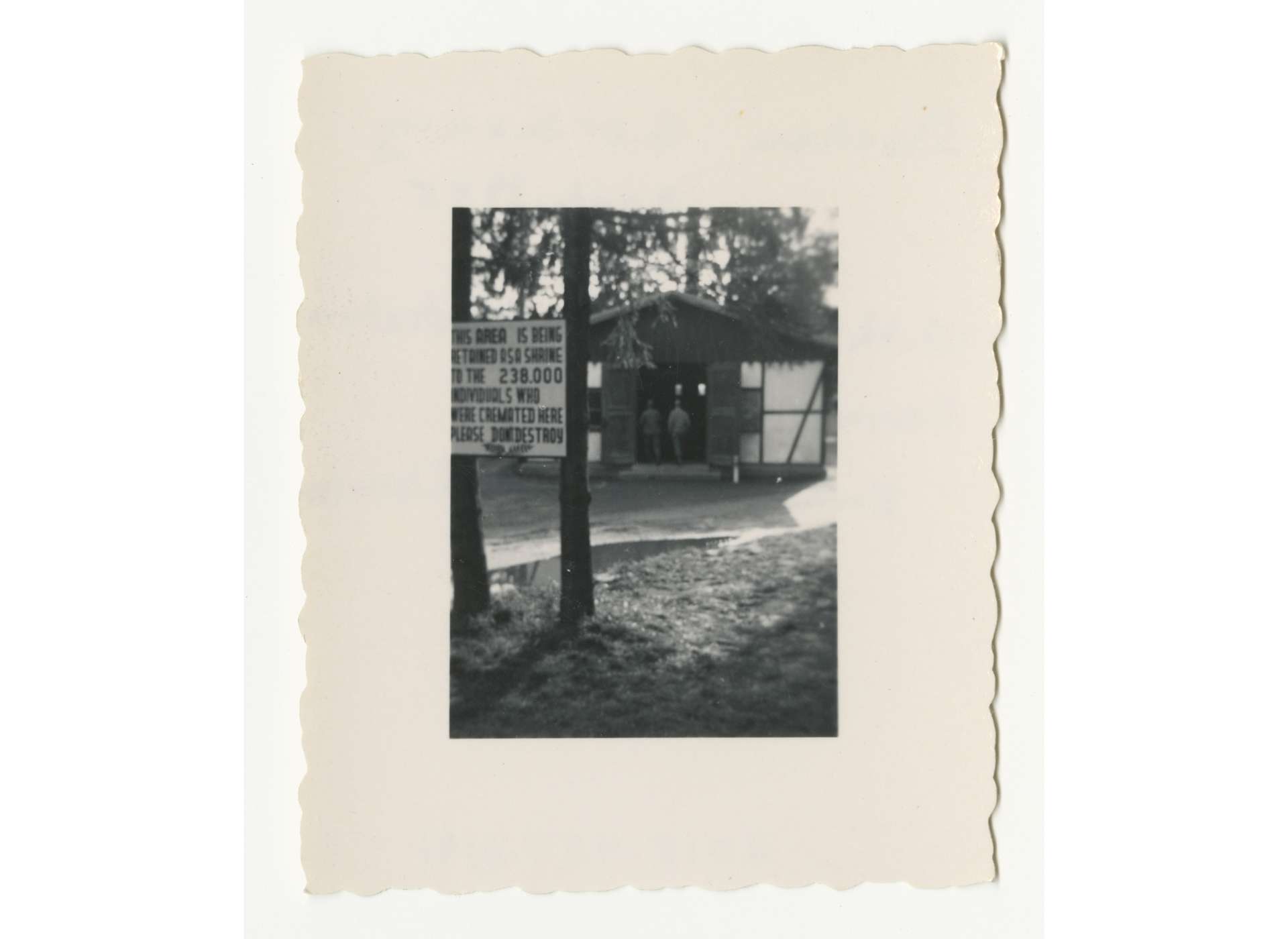
US personnel enter the gas chamber at Dachau. The sign with death statistics in the foreground is not correct. Over 41,000 people perished at Dachau. US Army Signal Corps Photo, Gift in Memory of Jack Hershkowitz, from the Collection of The National World War II Museum, 2015.457.114.
Crucially, Quinn’s people spoke as well with the townspeople of Dachau. His commentary on what they learned from these Germans is extremely revealing. When asked about the atrocities perpetrated in the neighboring concentration camp, so many of the town’s inhabitants replied, “Was könnten wir tun? (What could we do?)” Quinn related, “this statement would seem to represent the most popular attitude in the town of Dachau at present.” “They are liars, and guilty as sin—everyone,” he insisted Yet Quinn went on to state, “If one is to attempt the tremendous task and accept the terrific responsibility of judging a whole town, assessing it en masse as to the collective guilt or innocence of all of its inhabitants for this most hideous of crimes, one would do well to remember the fearsome shadow that hangs over everyone in a state in which crime has been incorporated and called the government.”
American Rabbi Max Eichhorn had been in the camp since April 30, the day Hitler committed suicide. He had acquired much experience serving as a Reform chaplain with combat units in Western Europe. Dachau represented an especially daunting challenge. The hatred Poles displayed for Jews, including Polish Jews, profoundly shocked Rabbi Eichhorn. Quinn, too, was profoundly unsettled by the breakdowns in solidarity between inmates uncovered in his interviews.
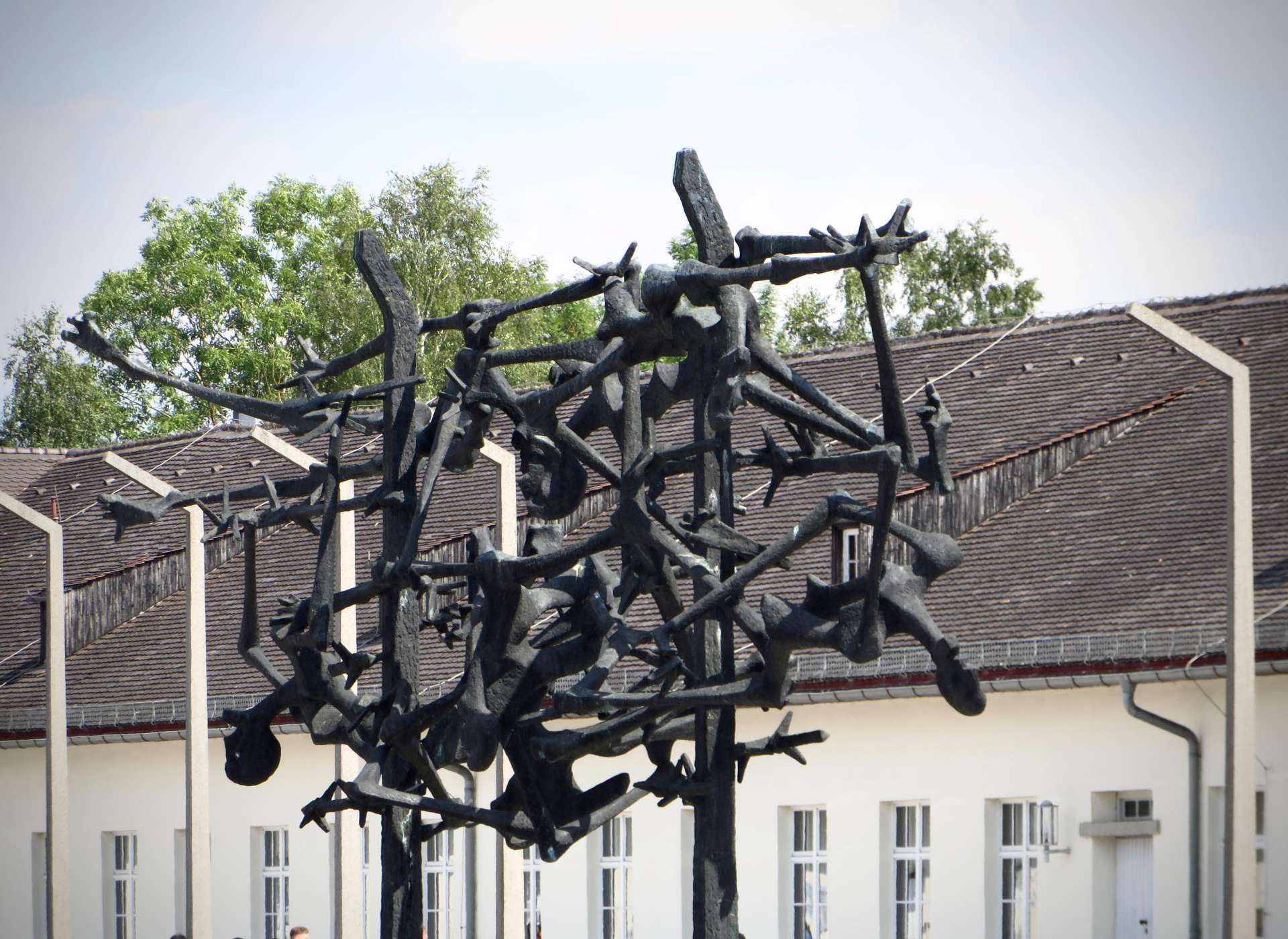
View of the International Memorial at Dachau, 2016. Credit: Jennifer Popowycz.
Dachau would forever be part of American memory of World War II. On April 29, 1945, troops from the 42nd and 45th Infantry Divisions, and tankers from the 20th Armored Division ended twelve years of Nazi barbarism in that insidious place where more than 41,000 human beings perished.
To this very day, visitors to the site of the camp can see for themselves what the Third Reich represented. In his report on Dachau, Quinn predicted that the concentration camp “will stand for all time as one of history’s most gruesome symbols of inhumanity. There our troops found sights, sounds and stenches horrible beyond belief, cruelties so enormous as to be incomprehensible to the normal mind. Dachau and death were synonymous.”
But perhaps it is better to conclude this series on Dachau with the words of Private First Class Clifford Barrett, one of the Liberators quoted by John McManus. After passing through the concentration camp, Barrett could not help but remember Frank Capra’s famous Why We Fight series he had viewed during Basic Training. “I’m sure when we finished Basic and were headed overseas, we all forgot those films,” he recalled. “But on April 29, 1945 in Dachau, we all indeed did know ‘Why We Fight.’”
Recommended Reading:
Evans, Richard J. The Third Reich at War 1939-1945. London: Penguin Books, 2008.
Höss, Rudolf. Death Dealer: The Memoirs of the SS Commandant at Auschwitz. Edited by Steven Paskuly. Boston: Da Capo Press, 1996.
Kershaw, Ian. The End: The Defiance and Destruction of Hitler’s Germany, 1944-1945. New York: The Penguin Press, 2011.
Kogon, Eugen. The Theory and Practice of Hell: The German Concentration Camps and the System Behind Them. Translated by Heinz Norden. New York: Farrar, Straus & Giroux, 1950.
Langbein, Hermann. Against All Hope: Resistance in the Nazi Concentration Camps 1938-1945. Translated by Harry Zohn. New York: Paragon House, 1994.
McManus, John. Hell Before Their Very Eyes: American Soldiers Liberate Concentration Camps in Germany, April 1945. Baltimore: Johns Hopkins University Press, 2015.
Marcuse, Harold. Legacies of Dachau: The Uses and Abuses of a Concentration Camp, 1933-2001. Cambridge: Cambridge University Press, 2001.
Pitzer, Andrea. One Long Night: A Global History of Concentration Camps. New York: Little, Brown and Company, 2017.
Quinn, William W. Dachau Liberated: The Official Report. United States Seventh Army, 1945.
Stone, Dan. The Liberation of the Camps: The Holocaust and Its Aftermath. New Haven: Yale University Press, 2015.
Syndor, Jr., Charles. Soldiers of Destruction: The SS Death’s Head Division, 1933-1945. Princeton: Princeton University Press, 1977.
The United States Holocaust Memorial Museum, entry on Dachau in The Holocaust Encyclopedia, and webpage on “Liberating Unit Histories and Insignia.”
Wachsmann, Nikolaus. KL: A History of the Nazi Concentration Camps. New York: Farrar, Straus, & Giroux, 2015.
www.kz-gedenkstaette-dachau.de/en (KZ Gedenkstätte Dachau)
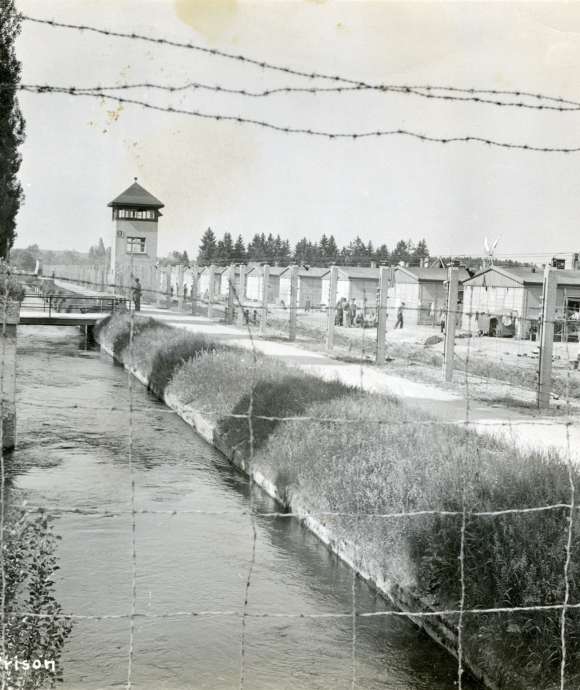
Part 1: Dachau, the “Model” Concentration Camp, 1933-39
In June 2004, while spending a weekend in Munich away from dissertation research at the Austrian National Library, I boarded a train in the city’s Hauptbahnhof (Central Station) for a short trip.
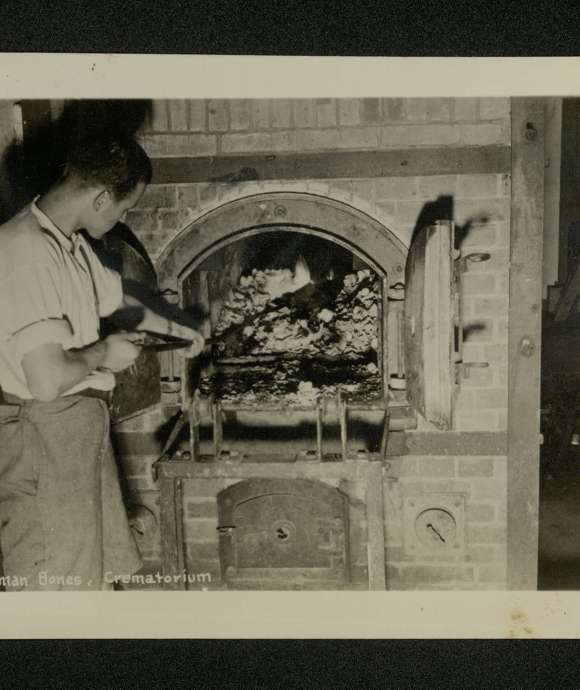
Part 2: A Shocking Level of Brutality and Degradation: Dachau in Wartime
Wartime reshaped life and death in the Dachau concentration camp in fundamental ways.
Jason Dawsey, PhD
Jason Dawsey, PhD, is ASU WWII Studies Consultant in the Jenny Craig Institute for the Study of War and Democracy.
Cite this article:
MLA Citation:
APA Citation:
Chicago Style Citation:
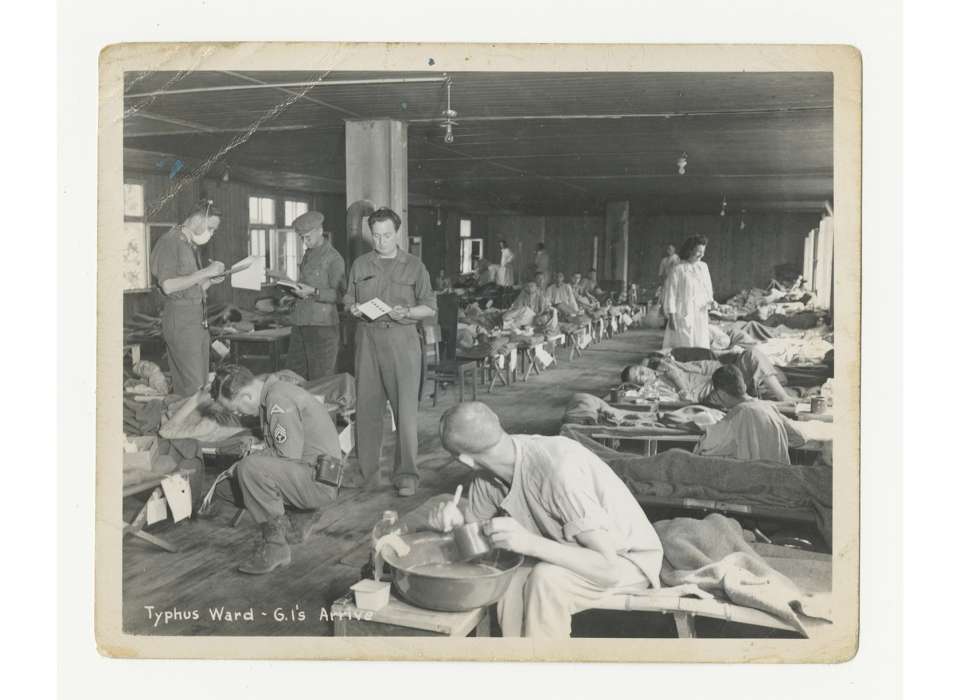




![Max Fuchs, New York City cantor, sings as Rabbi Sydney [sic] Lefkowitz, Richmond, VA, conducts the first Jewish services from Germany.](/sites/default/files/styles/max_650x650/public/2025-10/image1.jpg)



